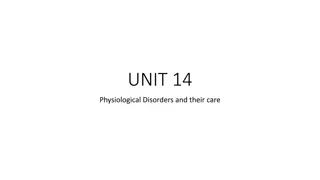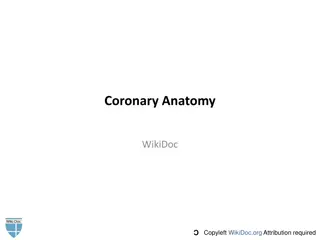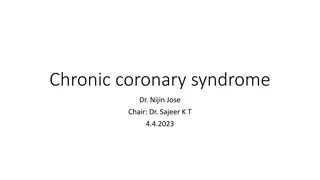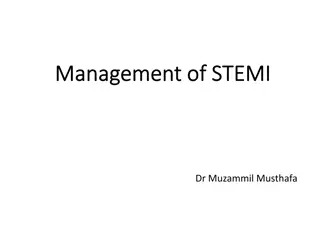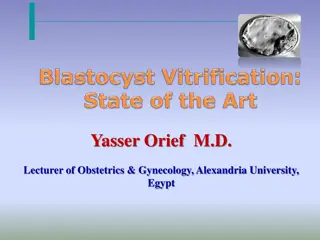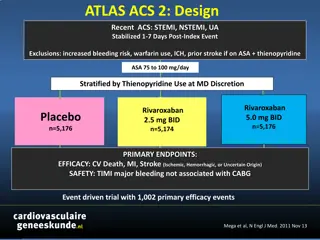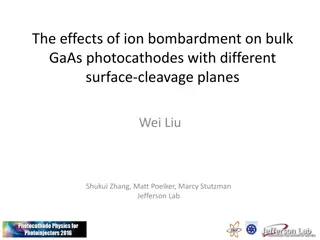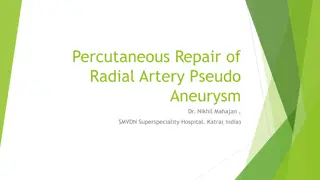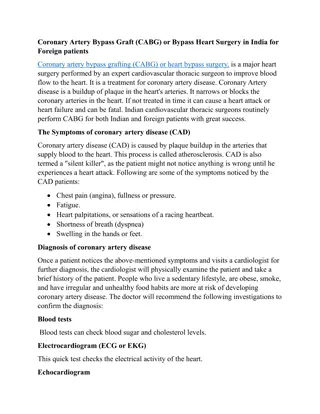Coronary Heart Disease
Coronary heart disease, including its introduction, pathophysiology, types, signs and symptoms, diagnosis, management, and risk factors. It also discusses the epidemiology and complications associated with the disease.
2 views • 23 slides
Non Coronary Vascular Stents
Safe scanning of patients with non-coronary vascular stents (NCVS) in MRI settings in NHS Scotland. It covers key questions regarding the safety of patients with NCVS, including risks associated with MRI at different strengths, timing of MRI post-stent implantation, and the safety of various stent m
1 views • 9 slides
Ticagrelor Monotherapy vs. 12-Month Dual Anti-Platelet Therapy After Coronary Stent Implantation for ACS
The study compares the efficacy of ticagrelor monotherapy after less than 1 month of dual anti-platelet therapy (DAPT) to 12-month ticagrelor-based DAPT in patients with acute coronary syndrome (ACS) undergoing percutaneous coronary intervention (PCI) with drug-eluting stent implantation. The aim is
1 views • 19 slides
REUNIÃO MENSAL - JULHO
Study conducted in Japan from March 2019 to April 2021 with 1,134 patients undergoing PCI guided by IVUS in multiarterial interventions. The aim was to assess clinical outcomes post-PCI optimization. Initial findings suggest potential benefits of IVUS guidance in achieving optimal stent expansion an
2 views • 30 slides
Understanding Coronary Artery Bypass Graft (CABG) in Adult Nursing
Coronary Artery Bypass Graft (CABG) is a surgical procedure where a blood vessel from another part of the body is grafted onto an occluded coronary artery to bypass blockages. This procedure is less common in women compared to men and is typically indicated for severe coronary artery disease. It is
5 views • 15 slides
best cataract surgeon in gurgaon
Dr Keya Barman stands out as a leading cataract surgeon, well-known for her expertise, patient-centric approach, and advanced surgical techniques. Dr. Keya Barman is an ophthalmologist specialising in cataract surgery and is known for her exactness, skill, and understanding of patient care. Dr. Barm
1 views • 2 slides
Placenta Accreta Syndrome: Definition, Risk Factors, Diagnosis, and Management
Placenta Accreta Syndrome (PAS) is characterized by abnormal placental implantation with firm adherence to the uterine muscle due to the absence of certain layers. Risk factors include previous cesarean section, placenta previa, advanced maternal age, and uterine anomalies. Diagnosis involves ultras
0 views • 16 slides
Understanding Cardiac Output and Venous Return in Cardiovascular Physiology
Cardiac output, stroke volume, end-diastolic and end-systolic volumes play vital roles in cardiovascular function. Factors affecting cardiac output include physiological conditions and pathological states like hyperthyroidism and myocardial infarction. Venous return, controlled by mechanisms like Fr
0 views • 27 slides
Understanding Heart Health: A Comprehensive Guide
Explore the critical roles of the aorta, pulmonary artery, and coronary arteries in heart function. Discover the impact of a blocked coronary artery and learn about treatments for coronary heart disease. Delve into common heart problems, like leaky valves and irregular heartbeat, and how innovations
0 views • 15 slides
Understanding Coronary Circulation and Arterial Supply in Cardiovascular Physiology
Explore the intricate details of coronary circulation, including arterial supply, branches of coronary arteries, and areas of distribution. Dr. Abeer Al-Masri, an Associate Professor and Cardiovascular Physiologist at the Faculty of Medicine, KSU, provides valuable insights on the topic, covering th
1 views • 30 slides
The Future of Brain-Computer Interfaces Perspective of Jaiinfoway
Neuralink's Groundbreaking Advances: A New Era of Brain-Computer Interfaces with Jaiinfoway\nExplore Neuralink's latest achievements in brain-computer interface technology, including the successful implantation in a second patient. Discover how these
0 views • 1 slides
Understanding Physiological Disorders: Rheumatoid Arthritis and Coronary Heart Disease
Explore the causes, effects, and treatment of Rheumatoid Arthritis and Coronary Heart Disease as part of investigating physiological disorders. Delve into the impact on the physical, mental, and emotional health of service users. Gain insights into the diagnosis, treatment, and support necessary for
0 views • 27 slides
Understanding the Impact of Nutrition on Coronary Heart Disease
Explore the relationship between nutrition and coronary heart disease through images depicting blood cholesterol levels, food pyramids for both healthy individuals and those with high cholesterol, and methods to increase fiber in your diet. Understand how cholesterol buildup in arteries can lead to
0 views • 13 slides
Understanding Coronary Artery Anatomy and Dominance
Explore the intricate details of coronary artery anatomy with a focus on the right and left coronary arteries, as well as variations such as large right dominance, small right dominance, co-dominance, and left dominance. Learn about the importance of understanding these structures in relation to car
0 views • 8 slides
Understanding Chronic Coronary Syndrome: Causes, Symptoms, and Management
Chronic coronary syndrome involves a dynamic process of atherosclerotic plaque accumulation and functional alterations in coronary circulation. It includes various clinical scenarios such as stable angina, asymptomatic ischemia, prior myocardial infarction, and more. The condition can be modified by
0 views • 131 slides
X-ray Image-Based Navigation for Hip Osteotomy Experiment
Experiment conducted using a cadaver specimen to assess the feasibility of BB implantation and visibility on X-ray images. The team cleared tissue, drilled burrs in the femur, attached BBs, and evaluated visibility and sizing on C-arm images. Results showed successful BB fixation. Predicted method f
0 views • 8 slides
Comparisons of Dyslipidaemia and Lesion Characteristics in Restenosis Groups
This supplemental content presents comparisons of dyslipidaemia, final minimal luminal diameter (MLD), distance between ostium of the LAD and proximal edge of the stent, lesion length, and various angle measurements in different restenosis groups. The findings highlight significant differences in dy
0 views • 4 slides
Global Gastrointestinal Stent Market
The Global Gastrointestinal Stent Market is expected to reach USD 0.75 Billion by 2032, at a CAGR of 4.8% during the forecast period 2022 to 2032.\n\n
1 views • 5 slides
Overview of Acute Coronary Syndrome and Myocardial Infarction
Acute Coronary Syndrome (ACS) encompasses a spectrum of conditions involving reduced blood flow in the heart. Ischemic Heart Disease (IHD) is a leading cause of mortality worldwide, with ST-elevation myocardial infarction (STEMI) being more common in younger men. Prompt diagnosis, treatment, and adh
1 views • 73 slides
AIDA Advanced Implantation Detector Array (AIDA) HISPEC/DESPEC Meeting
Presentation by Tom Davinson on behalf of the AIDA collaboration discussing the AIDA Support Stand, MBS data flow, tests conducted, data correlation with MBS events, and online data analysis pipeline for AIDA. The meeting covers integration progress, data handling processes, and upcoming development
0 views • 10 slides
Screening for Peripheral Vascular Disease in Patients with Coronary Artery Disease
Patients with coronary artery disease should be screened for peripheral vascular disease as it is a frequent integrator of global cardiovascular risk. The association of atherosclerosis in various arterial diseases highlights the importance of identifying multisite artery disease. The prevalence and
0 views • 23 slides
Understanding Acute Coronary Syndromes: Causes, Symptoms, and Risk Factors
Acute coronary syndromes (ACS) encompass a spectrum of conditions such as unstable angina, non-ST-segment elevated MI (NSTEMI), and ST-segment elevated MI (STEMI) that result from coronary artery occlusion. Risk factors for ACS include family history of heart disease, obesity, smoking, and hypertens
0 views • 20 slides
Comparison of Valve Types and Anesthesia Strategies in Transcatheter Aortic Valve Implantation
In the SOLVE-TAVI trial, patients undergoing transcatheter aortic valve implantation were randomized to receive either self-expandable or balloon-expandable valves under general or local anesthesia. The study aims to compare the effectiveness and safety of different valve types and anesthesia approa
0 views • 27 slides
Case Study: Successful Treatment of LAD Calcified Lesion with Percutaneous Coronary Intervention
A case study dated 2024/01/06 from Far Eastern Memorial Hospital involving the treatment of a calcified lesion in the LAD artery using percutaneous coronary intervention. The procedure included wire and sheath insertion, angiography, OCT imaging revealing severe calcification, rotablation, IVL, sten
0 views • 7 slides
Complex Case Study: CABG Surgery with Complications and Challenges
A 35-year-old male autodriver presented with dyspnea, chest pain, and a history of alcohol addiction. Past procedures included PTCA with stent in the LAD. Diagnostic tests revealed severe cardiac issues leading to CABG surgery with a twist involving pericardial adhesiolysis and cardiopulmonary bypas
0 views • 19 slides
Advancements in Hybrid Coronary Revascularization
Explore the evolution of hybrid coronary revascularization in cardiovascular care, guided by the 2011 ACC/AHA guidelines. This groundbreaking approach combines LIMA-to-LAD grafting with PCI for complex CAD cases, offering a promising alternative to traditional CABG or multivessel PCI. The integratio
0 views • 45 slides
Understanding Coronary Revascularization: Anatomy vs. Physiology
This content discusses the prevalence of angina in women compared to men, the importance of stable angina in predicting outcomes, the need for better diagnostic methods for coronary angiography, and the differences in obstructive CAD by sex and ethnicity in stable angina cases. It highlights the cha
0 views • 22 slides
Understanding Acute Coronary Syndrome Differentiation and Treatment
Learn to distinguish between STE and NSTE acute coronary syndromes in terms of diagnosis, prognosis, and treatment strategies. Understand the pathophysiological differences between ACS and chronic coronary syndromes. Gain insight into diagnostic approaches, treatment regimens, and prognosis for vari
0 views • 15 slides
Challenges and Techniques in Native RVOT Stenting for TOF+PS Patients
Native RVOT stenting in TOF+PS patients can be challenging due to anatomical complexities like short infundibulum and VSD. Different equipment and techniques are used for crossing tricuspid and pulmonary valves and delivering the stent. Dilating the pulmonary valve and addressing residual stenosis a
0 views • 22 slides
Overview of the First Week of Development from Ovulation to Implantation
The first week of development after ovulation involves key processes like fertilization, cleavage, and blastocyst formation. It begins with the maturation of the primary oocyte in the follicle, leading to ovulation and potential fertilization. During this period, hormonal changes in the ovarian cycl
0 views • 21 slides
Advantages of Blastocyst Transfer in Assisted Reproduction
Blastocyst transfer in assisted reproduction offers several advantages, including improved embryo selection, better synchronization with the female endometrium, reduced uterine contractions, and higher implantation rates. It also allows for cleavage stage embryo biopsy, decreases the risk of multipl
0 views • 34 slides
Pharmacodynamic Effects of Switching from Ticagrelor to Clopidogrel in Patients with Coronary Artery Disease: SWAP-4 Study
Pharmacodynamic effects of switching P2Y12 inhibitors from ticagrelor to clopidogrel in coronary artery disease patients were investigated in the SWAP-4 study. De-escalation between these agents is common for various reasons. The study assessed the impact of clopidogrel loading dose, maintenance dos
0 views • 11 slides
Clinical Trial Results of Rivaroxaban in ACS Patients: ATLAS-ACS 2 Study
The ATLAS-ACS 2 study investigated the efficacy and safety of rivaroxaban in ACS patients post-index event. The primary endpoints included cardiovascular death, MI, and stroke, with significant reductions seen with rivaroxaban compared to placebo. Stent thrombosis was also reduced with rivaroxaban t
0 views • 10 slides
Applications of Ion Implantation and Electron Beam Processing in Various Industries
Ion implantation and electron beam processing play crucial roles in industries such as semiconductor manufacturing, food preservation, surface hardening, waste treatment, and gemstone color modification. These processes involve the use of accelerators to deposit ions or generate electron beams for p
0 views • 20 slides
Ion Bombardment Effects on GaAs Photocathodes
Examining the impact of ion bombardment on bulk GaAs photocathodes with different surface-cleavage planes. Ion back-bombardment in photo-gun setups is a significant factor limiting the operating lifetime of photocathodes. Investigation includes H-ions implantation into GaAs, experimental apparatus d
0 views • 14 slides
Understanding Ectopic Pregnancy: Causes, Risks, and Management
Ectopic pregnancy occurs when the fertilized egg implants outside the uterus, most commonly in the fallopian tubes. This abnormal implantation can lead to serious complications, including maternal mortality. Risk factors include previous ectopic pregnancy, tubal surgery, and maternal age. Recognizin
0 views • 35 slides
Percutaneous Repair of Radial Artery Pseudoaneurysm - Case Study
A 61-year-old male with a history of diabetes, hypertension, and coronary artery disease presented with abnormal body movements suggestive of seizures. Following admission and neurology evaluation, a radial artery pseudoaneurysm was incidentally discovered. Percutaneous transluminal angioplasty (PTA
0 views • 5 slides
Understanding Acute Coronary Syndrome: Diagnosis and Immediate Therapies
A 58-year-old man presents with acute severe chest pain, diaphoresis, dyspnea, and risk factors for coronary heart disease. The most likely diagnosis is acute myocardial infarction. Immediate steps include placing the patient on a cardiac monitor, obtaining an ECG, and administering aspirin. Additio
0 views • 19 slides
Coronary Artery bypass graft - Bypass heart surgery
Coronary artery bypass grafting (CABG) or heart bypass surgery, is a major heart surgery performed by an expert cardiovascular thoracic surgeon to improve blood flow to the heart. It is a treatment for coronary artery disease. Coronary Artery disease
0 views • 3 slides
Coronary Angioplasty or Heart Stent Treatment in India
Heart Angioplasty or percutaneous transluminal coronary angioplasty (PTCA) means opening a blocked or narrowed coronary artery in the heart by using a balloon. Most modern coronary angioplasties are carried out by inserting a short wire mesh tube, ca
2 views • 4 slides











